Is cereal “the devil”? Is it impossible to dose for? Do we need to eliminate it from our diet now that T1D is in our lives? Or do we just need to figure out how to properly bolus for it? My son Jordan and I are doing an experiment of sorts. The goal: figure out how to dose for cereal without having a nasty bg spike. Do you think we can do it? Do you think you can do it? Let’s see!!
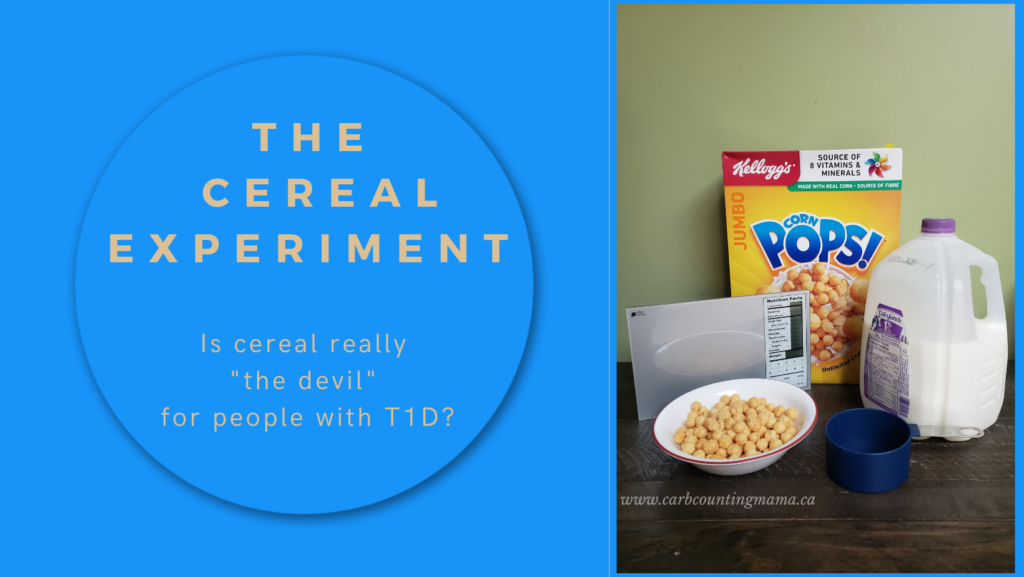
This post contains affiliate links
I am not a doctor or medical professional. This article is for informational purposes only. If you are thinking about changing the way you treat your diabetes, consult your medical team for assistance.
Some important info before we start:
- Before starting, we did a basal test and tested Jordan’s breakfast carb ratio. Both are accurate for his day-to-day life.
- Jordan currently manages his T1D with MDI. He tends to dose for food using his stomach as his injection site (yes, the location of the insulin injection is important for this experiment).
- The insulins he uses are Tresiba (which is considered to be an ultra-long-acting insulin with no discernable peak) and Fiasp (which is an ultra-rapid-acting insulin that starts working within a few minutes and has a duration similar to other rapid-acting insulins).
This may be similar to the way you manage T1D, or it might be very different. Different insulins and management methods will change the way all of this works. Even if you do things exactly the same way that Jordan and I do, this might not work the same for you. It’s meant as more of a demonstration than any kind of T1D instructions.
The goal:
The goal is quite simple. Eat a bowl of cereal without causing a significant spike or dip in bg.
The plan:
The plan is much more complicated. It has to be. T1D is complicated.
I don’t want anyone to think that I’m minimizing the amount of thought and effort that goes into bolusing for certain foods. While it is my personal belief that we can figure out how to bolus for any food, it’s usually not as simple as “dose for it and move on”.
Jordan and I have a plan going into this experiment. I want to share the details of our plan because it’s important for everyone to know what sort of thought goes into something as simple as a bowl of cereal.
Some of the things we’re taking into consideration:
- His current bg prior to having cereal. Ideally, we want this to start when his bg is steady and around 4-5 mmol/L (72-90 mg/dL). Starting on the lower end of our range is always ideal prior to eating.
- The macro profile of the cereal. Not just the carbs. We’re using Corn Pops and a run-of-the-mill 1% milk. No fancy cereal, no fancy milk. But we do need to know what’s in it.
- Weight of the food. I will yell this from the rooftops every chance I get. Measuring cups are not accurate at all. Always weigh things like cereal. Always. Here’s a great food scale to use if you don’t have one.
- Insulin timing. This is a big one. Do we need to prebolus? How long should the prebolus be?
- What’s happening after he eats? Is he going to be active? Is he sitting around playing video games? Activity level makes a difference in insulin sensitivity. We need to factor that in.
Back to the actual plan
Since we’ve basal tested, in theory, we should be able to start the experiment with his bg around 4-5 mmol/L (72-90 mg/dL). I might have to get up a couple of times during the night to make it happen, but who needs sleep anyway?
The macro profile for this specific breakfast is:
2 servings of corn pops: 52grams of carbs, 2 grams of protein, 0 grams of fat
1 cup of milk: 12 grams of carbs, 9 grams of protein, 2.5 grams of fat
Totals: 64 grams of carbs, 11 grams of protein, 2.5 grams of fat
That macro profile is based on the weight of the cereal. Here’s what the macro profile tells me. It’s very carb-heavy or carb-forward. I don’t mean that 64 grams is a lot of carbs. What I mean is that compared to the protein and fat, the carbs are winning… by a lot.
You’re kind of looking for a ratio. The more the carbs outweigh the protein and fat, the longer the prebolus will need to be. If the protein and fat outweigh the carbs, you might not need a prebolus at all. This breakfast will need more of a prebolus than our usual sausage, eggs, and English muffin because it’s much more carb-forward than our usual meal.
Now, since we are currently using Fiasp, which is an ultra-rapid-acting insulin, we’ll start with a 5 minute prebolus. Other insulins would likely need a longer prebolus.
Foods that are carb-forward also tend to need more insulin than other foods. 64 grams of carbs for a bowl of cereal will likely need more than 64 grams of carbs in our usual breakfast. We adjust our ratio for very carb-forward macro profiles.
That’s most of what we’ve considered before attempting to bolus for cereal with no spike. So, let’s get to it.
Cereal experiment, first attempt
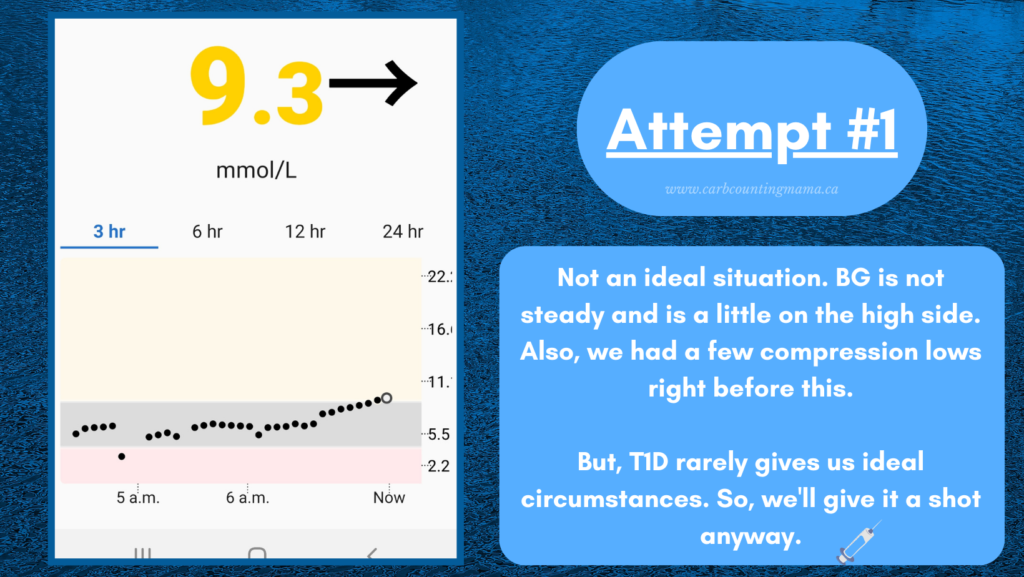
Here’s Jordan’s Dexcom line before eating. As you can see, his bg was sitting at 9.3 (167) when we started. That’s quite a bit higher than we had planned, and it’s still going up… so we’re going to add a unit of insulin for his bg and prebolus 6 minutes instead of 5.
His current ICR is 1:9, but cereal generally needs more insulin, so we’re going to use a 1:8 ratio instead. Today, he’s walking to school after breakfast and he has math class during first period. He’ll be a bit active, but nothing excessive or out of the ordinary.
A 1:8 ratio means 8 units of insulin for the bowl of cereal. Plus a unit for his current bg.
With a 6 minute prebolus and 9 units of insulin, here’s his graph 3 hours later:
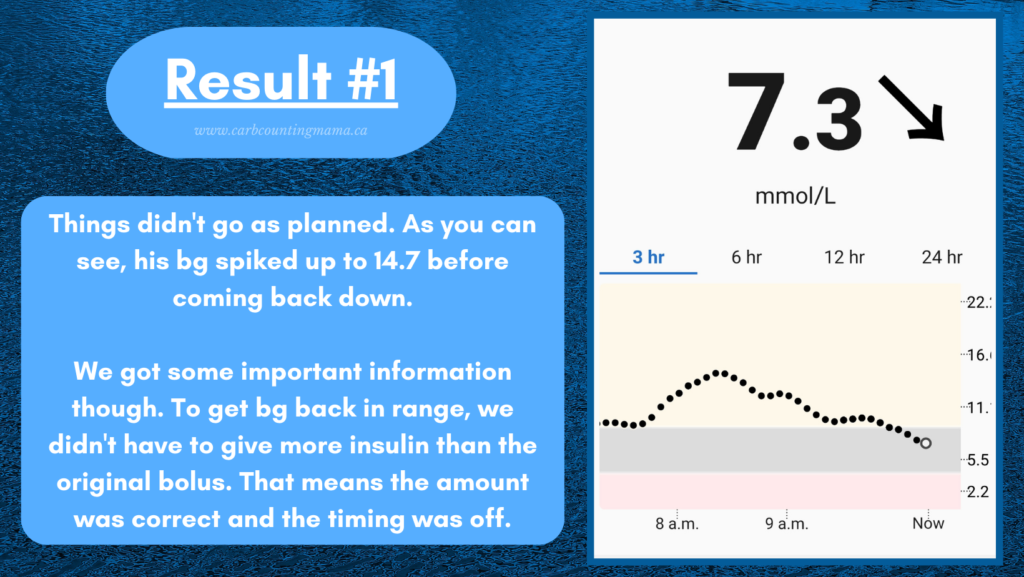
So, what does this mean? Was the experiment a success?
We certainly weren’t successful in avoiding a spike. Jordan promptly spiked up to 14.7 (264). But we did get some important information from our first attempt.
During the 3 hours after eating his cereal, Jordan did not give more insulin or eat any more food. He did spike, but his bg came right back to where we wanted it by the time the dose wore off. That tells us that the amount of insulin we gave was right, it was just timed wrong.
Alternately, if it had gone high and stayed high, that would tell us that we hadn’t given enough insulin.
It’s time to make a couple of tweaks to our plan and get ready for attempt #2. Hopefully, we can start with his bg in the planned range this time!
Cereal experiment, second attempt
Unfortunately, we started at roughly the same bg as our first attempt. It’s really important to try to start on the lower end of our range. I’ll explain more about why in a minute.
Here’s the graph of the 3 hours prior to our second try at bolusing for cereal:
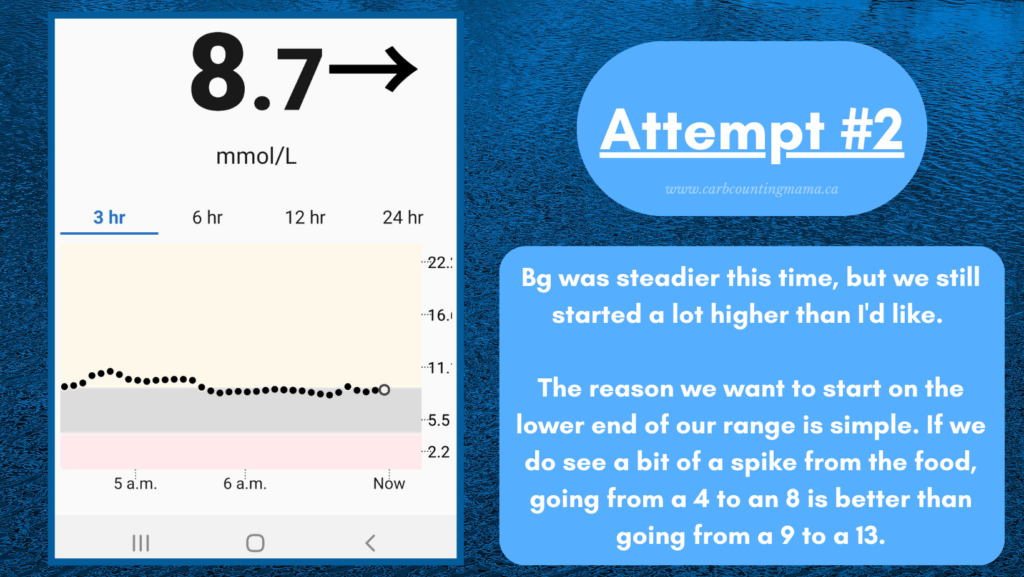
We used the same 1:8 ICR and prebolused 8 minutes instead of 6. He also added a unit of insulin for his blood glucose level again.
Like our first attempt, he was walking to school and had math first period. Unlike our first attempt, his bg was steady rather than going up.
Again, he gave 9 units. This time we prebolused 8 minutes, 2 more than our last attempt.
And here’s what happened:
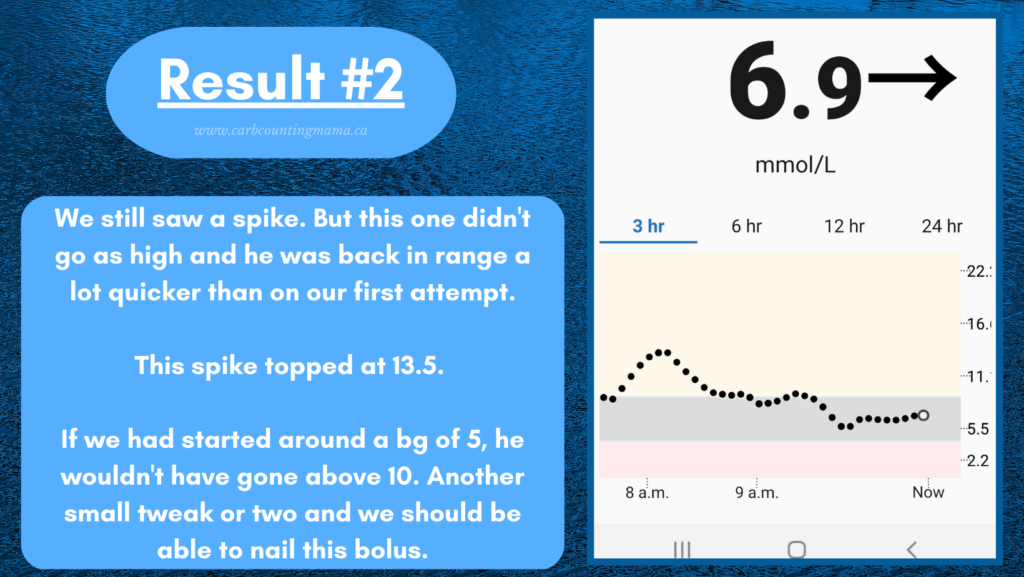
Still unsuccessful, but getting closer
We still saw a spike from the cereal. His bg didn’t go as high, this time going up to 13.5 (243) before coming back down. But more importantly, it came back into range and leveled off a lot quicker. Almost an hour faster than the previous attempt.
Two major factors contributed to this.
- His bg trend. On our first attempt, his bg was going up. It was slight, but it was happening. On the second attempt, his bg was steady. This doesn’t mean we have to skip the cereal if bg is going up, but we do have to take it into account a little more than we bargained for.
- The prebolus. You wouldn’t think 2 minutes could make such a difference, but it can. And that’s really important to keep in mind when you’re starting at different bg levels. I would never have given an 8 minute prebolus if he had started at 4 or 5 like we were planning.
Again, the amount of insulin seems to be correct. We didn’t need to give a second bolus either day to bring his bg back into range. The problem is his starting bg and the insulin timing. Fingers crossed for attempt #3!
Cereal experiment, third attempt
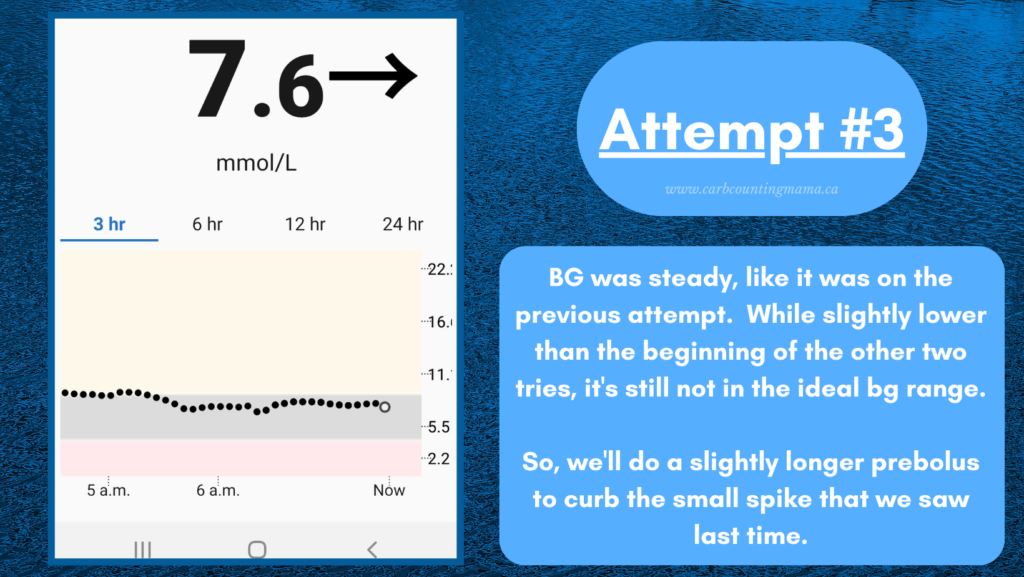
We started with a very similar bg and line as the ones we had on attempt #2. Ideally, his bg should have been lower, but it’s kind of good that this happened.
This will really highlight the importance of prebolus timing.
Since we started with a very similar graph, and the previous attempt had a bit of a spike, we did everything the same except added a couple of minutes to the prebolus.
The insulin amount was the same, 9 units. The amounts of cereal and milk were the same. He had the same morning routine, walking to school and math for his first period.
The only thing we changed was the prebolus time. Instead of 8 minutes, we prebolused 10. That’s it. And look at what happened.
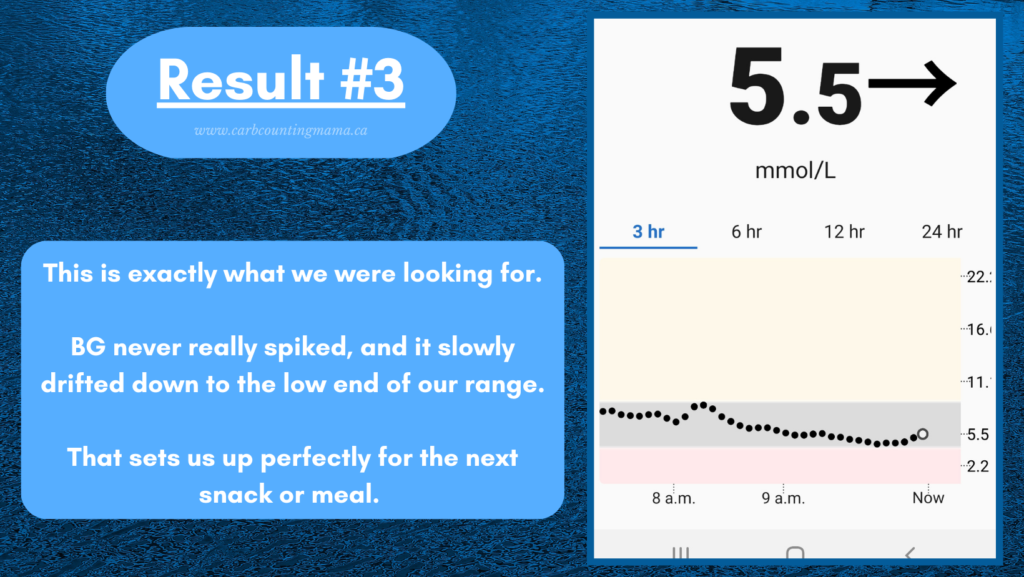
We nailed it.
There wasn’t a significant dip or spike. At all.
This is what makes T1D so complicated. This is why roller coaster numbers are the norm for most people with T1D. You can’t just use the same carb ratio for every food. You can’t prebolus a set number of minutes and expect good results each time.
If you “just dose and move on”, you will see highs and lows, lots of them.
But that doesn’t mean it’s impossible. It doesn’t make certain foods forbidden or “the devil”. It just means we have to put in some extra time and effort to learn how different foods and insulin work together.
A couple of minutes makes a difference. The starting bg number and trend make a difference. The macro profile of the snack or meal makes a difference.
And honestly, it can be a lot of work to figure this stuff out. Some people naturally catch on intuitively. Others have a more scientific approach.
Many people try to do the same thing every time and expect the same results. As you can see, very small adjustments change the result quite a bit. So, you might think you’re doing the same thing every time, but are you really?
The next time you see a food item that makes you nervous to dose for, take a few minutes to analyze the factors and come up with a plan. You might be surprised at how often that helps you avoid spikes in bg.
Here are some additional tips that might be helpful when you eat cereal: How to bolus for cereal without the spike
What are your thoughts on cereal and T1D? Is it straightforward? Does it make you feel like it’s impossible? Let’s discuss it. Leave a comment below!
For more tips and stories about T1D, join the Carb Counting Mama email list, and make sure to head over to the Carb Counting Mama Facebook page and “like” it.
Leave a Reply